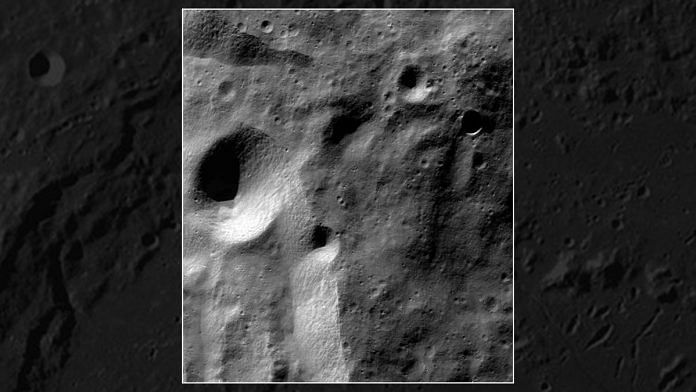New Delhi: Using data from a NASA instrument onboard India’s Chandrayaan-1 mission, scientists have, for the first time, found the oxidised iron mineral hematite at high latitudes on the Moon.
The findings come as a surprise to planetary scientists since the lunar surface is virtually devoid of any oxygen.
Iron is highly reactive with oxygen and forms rust, which is commonly seen on Earth. However, on the Moon, the hydrogen in solar wind blasts the surface, which acts in opposition to oxidation. This makes the presence of highly oxidised iron-bearing minerals, such as hematite, on the Moon an unexpected discovery.
According to researchers from University of Hawai’i, the lunar hematite may have formed with the help of oxygen from the Earth’s upper atmosphere that has been continuously blown to the lunar surface by solar winds during the past several billion years. More on Live Science.
Arctic wildfires break carbon dioxide emission records
Wildfires raging across the Arctic — which resulted in smoke plumes covering the equivalent of more than a third of Canada — have broken last year’s records for carbon dioxide emissions this summer.
According to scientists from the Copernicus Atmosphere Monitoring Service, this year’s CO2 emissions from the Arctic Circle fires have increased by just over a third compared with 2019.
From 1 January to 31 August this year, an estimated 244 megatonnes of CO2 was emitted from the region. In comparison, the wildfires throughout 2019 released 181 megatonnes of CO2 into the atmosphere.
Most of the increased wildfire activity has been seen in Russia’s Sakha Republic, destroying millions of acres of land. Some fires early in the season are thought to have been caused by what are known as ‘zombie fires’, which may have been smouldering underground during the winter months.
The peak of the Arctic fire season was in July and early August, with regions in Russia experiencing above-average daily total wildfire intensity in August. More on CNN.
Also read: Scientists discover three stars ripping apart their planet-forming disc
Greenland ice sheet crossed tipping point 20 years ago
A team of researchers from Columbia University has said that the Greenland ice sheet crossed its tipping point around two decades ago.
While the ice sheet’s decline has been well-documented over the past 20 years, the study suggests that even if the oceans and atmosphere were to stop warming today, the ice sheet will continue to lose more ice than it will gain.
Until the turn of this century, the ice sheet was in a state of equilibrium. The ice lost in a year would be replenished by wintertime snowfall, and the sheet maintained a near-constant mass.
However, since the year 2000, the researchers say, ice loss started to outpace annual snowfall. The team sifted through 40 years of satellite data to determine the rate of ice loss. The shift they found represents a tipping point that is unlikely to be reversible in the near future. More on The Guardian.
Researchers estimate the true size of prehistoric megalodon
Scientists have estimated the actual size of an enormous prehistoric mega-shark, the largest known so far, which has also inspired Hollywood films such as The Meg.
Megalodons are thought to have lived from about 23 million to 3 million years ago. They are believed to have gone extinct as a result of ocean cooling during the ice ages, along with the lowering of sea levels and resulting loss of suitable nursery areas.
Until now, only the length of the Otodus megalodon species had been estimated. A team from the University of Bristol and Swansea University has now determined the size of the rest of its body, saying its fins were as large as an adult human.
The team used mathematical methods and comparisons with living relatives to find the overall size of the megalodon. For example, the great white shark — depicted in the 1975 movie Jaws — is a distant descendant of the megalodon and can often grow up to more than 6 metres in length.
The results suggest a 16-metre megalodon is likely to have had a head about 4.65 metres long, a dorsal fin 1.62 metres tall, and a tail 3.85 metres long. This means an adult human could stand on the back of the shark and be about the same height as the dorsal fin. More on Forbes.
Study makes a case against trophy hunting of male elephants
A study involving researchers from the University of Exeter has claimed that older male elephants have an important role to play in the continuation of the species — mentoring and teaching younger ones. The team found that adult bull elephants were more likely to travel at the front of groups of males, suggesting they may be important leaders with valuable ecological knowledge.
Older female elephants lead groups of daughters and their calves, while males grow up and leave the herd. According to the study, mature bull elephants play an important role in leading these younger males.
The idea that lone older males do little for the survival of the species has been used as an argument to support legal trophy hunting of old males of the species.
However, the study shows that the poaching or hunting of these solitary males could have a disastrous impact on the future of the species. More on the BBC.
Also read: 32 bat species identified in Uttarakhand, 9 of these recorded for first time in the world







The sun shall be turned into darkness, and the moon into blood, before the great and terrible day of the Lord,” – Joel 2:31. “The sun shall be turned into darkness, and the moon into blood, before the great and notable day of the Lord.” – Acts 2:20